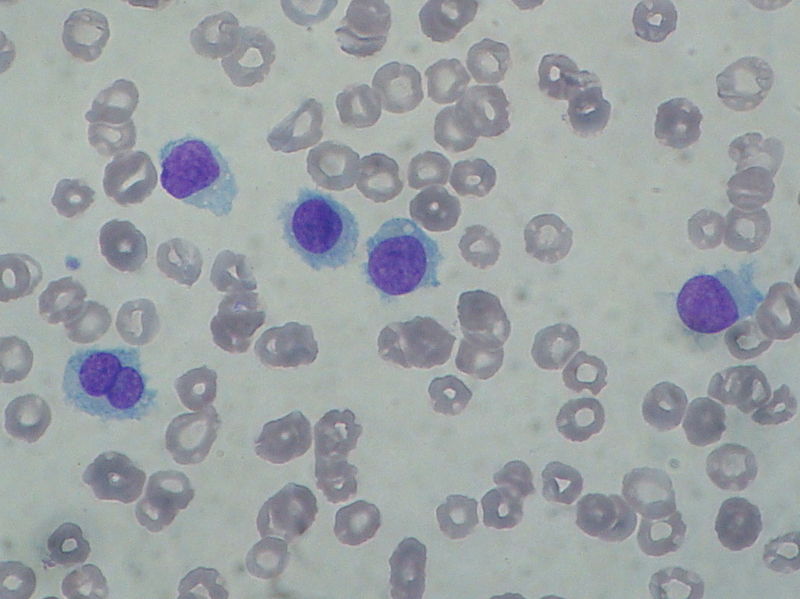WBR0781
Jump to navigation
Jump to search
| Author | [[PageAuthor::Serge Korjian M.D. (Reviewed by Serge Korjian)]] |
|---|---|
| Exam Type | ExamType::USMLE Step 1 |
| Main Category | MainCategory::Pathology |
| Sub Category | SubCategory::Hematology, SubCategory::Oncology |
| Prompt | [[Prompt::A 32-year-old man presents to his primary care physician for 1 month of weakness and fatigue. The patient reports that he has also been short of breath with minor activity. On physical exam, the physician notices several bruises on the patient’s abdomen and lower extremities, although the patient denies any trauma. Splenomegaly is also noted 5 cm below the left costal margin. The physician orders a set of labs and a blood smear shown below. What other findings do you expect to observe?
Hemoglobin = 6.8
MCV = 78
White Blood Cells = 17230
%Neutrophils = 4%
%Lymphocytes = 96%
Platelets = 3000
|
| Answer A | AnswerA::Terminal deoxynucleotidyl transferase positivity on immunohistochemistry |
| Answer A Explanation | AnswerAExp::Terminal deoxynucleotidyl transferase (TdT) is a DNA polymerase expressed in immature B and T cells and is used in the diagnosis of acute lymphoblastic leukemia specifically pre-B and pre-T subtypes. |
| Answer B | AnswerB::Peroxidase positivity |
| Answer B Explanation | AnswerBExp::Peroxidase positivity is seen in AML cells due to the presence of Auer rods. |
| Answer C | AnswerC::Schistocytes |
| Answer C Explanation | AnswerCExp::Schistocytes are seen in patients with microangiopathic hemolytic anemia like TTP or DIC. |
| Answer D | AnswerD::Bite cells and Heinz bodies |
| Answer D Explanation | AnswerDExp::Both bite cells and heinz cells are seen in patients with hemolytic anemia secondary to G6PD deficiency. |
| Answer E | AnswerE::Tartrate-resistant acid phosphatase stain positivity |
| Answer E Explanation | AnswerEExp::Tartrate-resistant acid phosphatase (TRAP) positivity is typical of hairy cell leukemia. |
| Right Answer | RightAnswer::E |
| Explanation | [[Explanation::Hairy cell leukemia is a slowly progressive hematologic malignancy classically seen in older males. Patients usually present with anemia, thrombocytopenia and neutropenia despite normal or elevated white cell count. On physical exam, splenomegaly is common with easy bruising secondary to low platelets. Diagnosis is usually made by peripheral blood as well as bone marrow smear showing characteristic hairy cells (white blood cells with irregular, hair-like margins). The origin of hairy cells is B-lymphocytes although they may exhibit features of monocytes. The diagnosis can be confirmed by staining with tartrate-resistant acid phosphatase (TRAP). TRAP is a glycosylated enzyme expressed normally in other tissues (osteoclasts) but is markedly increased in "hairy cells". Patients are usually at very high risk of infection given their immune status. Educational Objective: Hairy cell leukemia presents with cytopenia and splenomegaly with peripheral and bone marrow smear showing hairy cells. Tartrate-resistant acid phosphatase (TRAP) positivity may be used to confirm the diagnosis. |
| Approved | Approved::Yes |
| Keyword | WBRKeyword::Hairy cell leukemia, WBRKeyword::TRAP, WBRKeyword::Leukemia |
| Linked Question | Linked:: |
| Order in Linked Questions | LinkedOrder:: |
